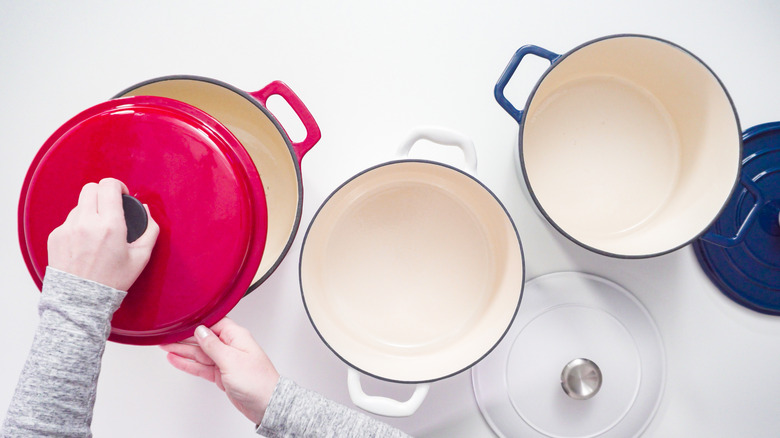What Do I Use If I Don't Have A Dutch Oven?
Recipes that call for a Dutch oven run the gamut from stove top deep-fried chicken to oven-baked breads to campfire soups. Dozens of Dutch oven uses make it a staple piece of cookware in both traditional and modern kitchens. Why own (and clean and store) specialty pots, pans and baking dishes when a Dutch oven accomplishes the same tasks?
Tip
Understand which cooking techniques (browning, baking, frying, etc.) are used in a Dutch oven recipe and select other pots and pans according to their function.
What Is a Dutch Oven?
What Is a Dutch Oven?
As it turns out, there's a very practical reason why you may not favor using a Dutch oven: they're heavy. Traditionally, Dutch ovens are made of cast iron — and a thick layer of it at that. Cast iron certainly has its advantages, including a nonstick quality when properly seasoned, but modern Dutch ovens are also made of lighter materials like aluminum or ceramic.
The distinguishing features of a Dutch oven, regardless of the material it's made of, include a wide, circular base, a deep belly and a tight-fitting lid. Do some of your existing pots and pans already fit that bill? If so, you probably have a perfect Dutch oven substitute already waiting in your cabinets. Learn more about why a recipe calls for a Dutch oven before choosing the very best alternative cookware.
Dutch Oven Uses
Dutch Oven Uses
Although Dutch ovens can handle a variety of recipes, one genre in which they absolutely shine is the "one-pot meal." The wide, flat bottom of a cast iron Dutch oven is perfect for sauteing vegetables before adding water or broth, followed by anything from meat to rice to pasta. You can boil a dish on the stove and then transfer it to the oven for a slow roast to blend the flavors. A Dutch oven makes one-pot meals convenient, but your "one-pot" doesn't have to be a Dutch oven or even a single pot if you don't have cookware that can handle a stove-to-oven transition.
Dutch ovens are also popular for campfire cooking. Some of them have legs and a wire hanger to make them especially useful for this setting, but given the weight of cast iron, you won't want to lug a Dutch oven much farther than your backyard fire pit. That means you'll want to look for a campfire-appropriate Dutch oven substitute for treks into the wilderness.
Alternative to a Dutch Oven
Alternative to a Dutch Oven
A Dutch oven's prowess comes from its ability to perform so many functions in a single humble pot. Therefore, your goal is to read through a recipe and identify the different cooking techniques it calls for. Then, you'll find cookware in your home that can perform those individual functions. To create the final meal, you may need to combine the finished products from the separate pots and pans, but you'll still have a delicious dinner to enjoy.
Dutch Oven Substitutes
Dutch Oven Substitutes
First, do you have a slow-cooker or multicooker like an Instant Pot? Recipes that call for simmering a one-pot meal on the stove or baking it in the oven can often be replicated with these kitchen appliances. If a meal needs to go straight from the stove top to the oven, use a cast iron skillet (cover the skillet with aluminum foil if it doesn't have a lid).
For sauteing, browning or pan-frying, use any skillet or a wok. For boiling pasta or hard-boiled eggs, making rice or preparing soup, use an appropriately sized saucepan or stockpot. To deep-fry, choose the deepest stove top pot you have available.
A casserole dish with a lid can easily bake anything in the oven that would otherwise be baked in a Dutch oven. Bread pans and baking dishes made of any material will also do the trick. Keep in mind that the baking times and temperatures will vary depending on whether you use glass, ceramic, stone, cast iron or aluminum bakeware. Keep a close eye on the progress of a recipe meant to be baked in a Dutch oven.
